Chinese Nationalist Party (KMT) Chairman Wu Poh-hsiung (吳伯雄) met Chinese President Hu Jintao (胡錦濤) in Beijing yesterday.
Wu met Hu in the highest-level talks between leaders of China and Taiwan in the 60 years since the KMT retreated to Taiwan at the end of the Chinese civil war.
Hu called the visit a “big event between our two parties,” and said sympathy and aid from Taiwan for victims of the devastating earthquake in Sichuan Province had “moved us deeply.”
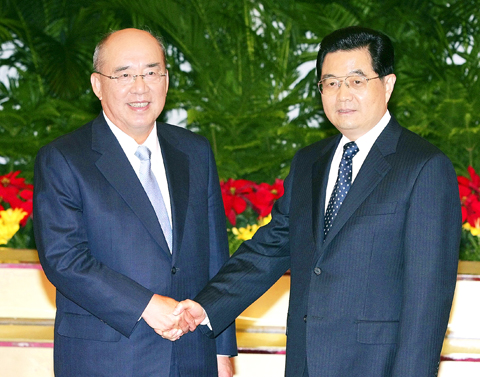
PHOTO: AP
In a televised meeting before formal talks at Beijing’s Great Hall of the People, Wu offered Taiwan’s help with reconstruction work in Sichuan and said the “love and concern of the Taiwanese people was self-motivated.”
“Neither of us can promise that there will be no disasters across the [Taiwan] Strait,” Wu said. “But both of us can promise that, through our joint efforts, there will never be a war across the Strait.”
Citing as an example of Taiwan’s concern for the Sichuan quake victims, Wu said KMT Deputy Secretary-General Steve Chan (詹啟賢) was unable to be a part of his delegation because the surgeon was visiting Sichuan at the head of a medical aid team.
Hu met Wu in his capacity as head of the Chinese Communist Party (CCP), following the “party- to-party” protocol of previous meetings between Chinese leaders and KMT officials.
Following their one-hour meeting, Wu told a press conference that the two had exchanged views on the issues of cross-strait economic and trade relations, Taiwan’s security and international space.
Wu said he told Hu that Taiwanese want security, dignity and international space, and that Hu said that was understandable.
He also said he and Hu shared many views of the positive nature of future cross-strait exchange, and that there was a chance that the “clouds will be dispelled.”
Talking about chartered weekend flights and Chinese tourists traveling to Taiwan, Wu said both he and Hu had made mention of these issues, but that the details would be negotiated by the Straits Exchange Foundation and China’s Association for Relations Across the Taiwan Strait.
Although the KMT could not represent [the government], Wu said, the atmosphere during this meeting gave him reason to believe that “[weekend chartered flights and Chinese tourists traveling to Taiwan] will be handled quickly.”
Hu promised to discuss Taiwan’s participation in international organizations, including the World Health Organization (WHO), in future talks.
The KMT’s Mainland Affairs Division director, Chang Jung-kung (張榮恭), said Hu indicated that China cared about and respected Taiwanese, and would take measures to reconcile the two sides.
He added that Hu said the Chinese government understood the frustration of Taiwanese in seeking to join global organizations, and promised to make the issue a priority, including Taiwan’s goal of joining the WHO.
Wu arrived in Nanjing on Monday and will visit Shanghai and Yixing in Jiangsu Province before he returns home on Saturday.
Also see: DPP cautiously welcomes China talks
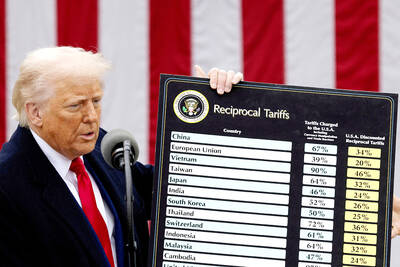
WAITING GAME: The US has so far only offered a ‘best rate tariff,’ which officials assume is about 15 percent, the same as Japan, a person familiar with the matter said Taiwan and the US have completed “technical consultations” regarding tariffs and a finalized rate is expected to be released soon, Executive Yuan spokeswoman Michelle Lee (李慧芝) told a news conference yesterday, as a 90-day pause on US President Donald Trump’s “reciprocal” tariffs is set to expire today. The two countries have reached a “certain degree of consensus” on issues such as tariffs, nontariff trade barriers, trade facilitation, supply chain resilience and economic security, Lee said. They also discussed opportunities for cooperation, investment and procurement, she said. A joint statement is still being negotiated and would be released once the US government has made
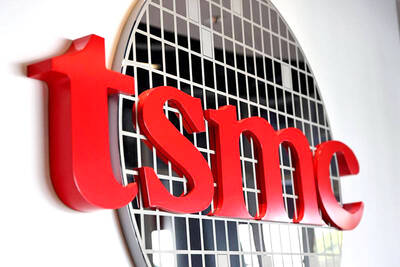
Authorities have detained three former Taiwan Semiconductor Manufacturing Co (TMSC, 台積電) employees on suspicion of compromising classified technology used in making 2-nanometer chips, the Taiwan High Prosecutors’ Office said yesterday. Prosecutors are holding a former TSMC engineer surnamed Chen (陳) and two recently sacked TSMC engineers, including one person surnamed Wu (吳) in detention with restricted communication, following an investigation launched on July 25, a statement said. The announcement came a day after Nikkei Asia reported on the technology theft in an exclusive story, saying TSMC had fired two workers for contravening data rules on advanced chipmaking technology. Two-nanometer wafers are the most
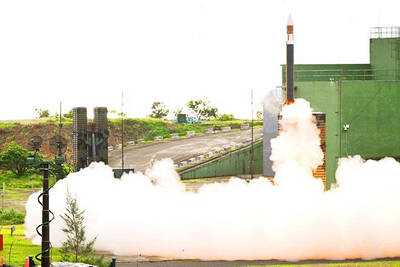
NEW GEAR: On top of the new Tien Kung IV air defense missiles, the military is expected to place orders for a new combat vehicle next year for delivery in 2028 Mass production of Tien Kung IV (Sky Bow IV) missiles is expected to start next year, with plans to order 122 pods, the Ministry of National Defense’s (MND) latest list of regulated military material showed. The document said that the armed forces would obtain 46 pods of the air defense missiles next year and 76 pods the year after that. The Tien Kung IV is designed to intercept cruise missiles and ballistic missiles to an altitude of 70km, compared with the 60km maximum altitude achieved by the Missile Segment Enhancement variant of PAC-3 systems. A defense source said yesterday that the number of
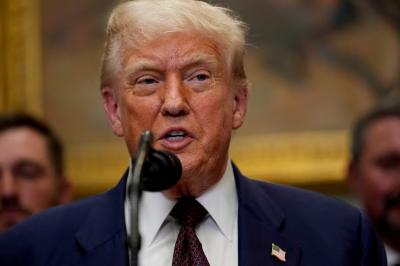
Taiwanese exports to the US are to be subject to a 20 percent tariff starting on Thursday next week, according to an executive order signed by US President Donald Trump yesterday. The 20 percent levy was the same as the tariffs imposed on Vietnam, Sri Lanka and Bangladesh by Trump. It was higher than the tariffs imposed on Japan, South Korea and the EU (15 percent), as well as those on the Philippines (19 percent). A Taiwan official with knowledge of the matter said it is a "phased" tariff rate, and negotiations would continue. "Once negotiations conclude, Taiwan will obtain a better